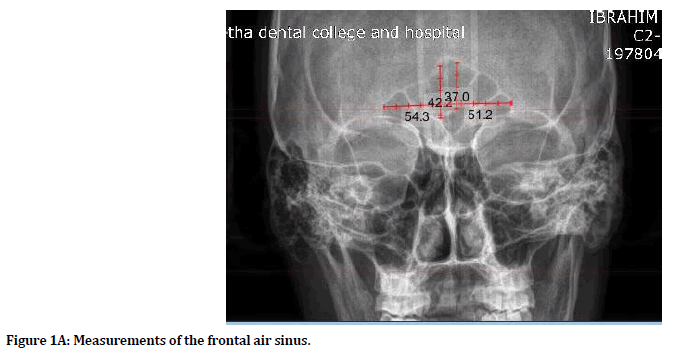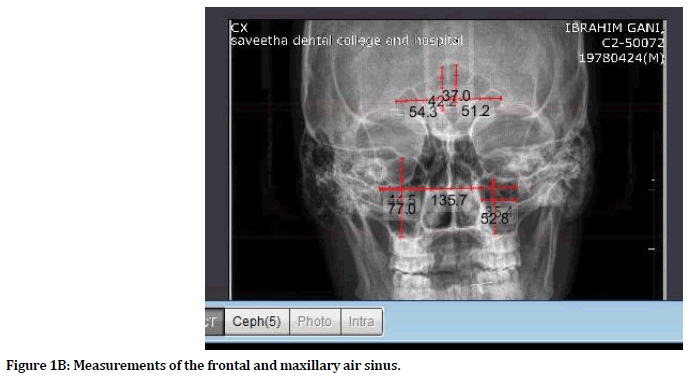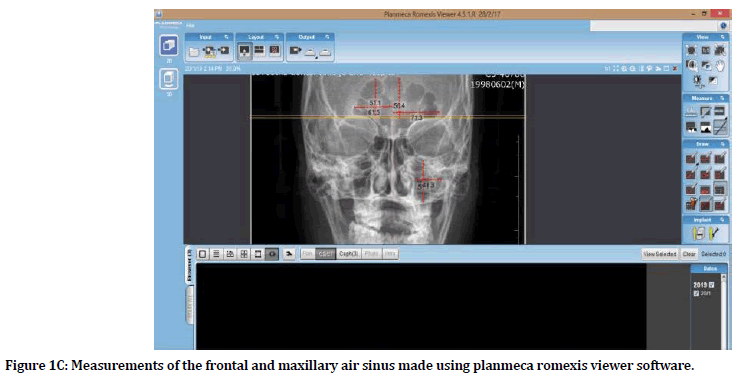Research - (2020) Volume 8, Issue 3
Frontal and Maxillary Air Sinus in Age Determination and Gender Identification
Anu Netharaa*, Pratibha Ramani, Herald J Sherlin, Gheena S, Abilasha Ramasubramanian, Gifrina Jayaraj, KR Don and Archana Santhanam
*Correspondence: Anu Netharaa, Department of Oral and Maxillofacial pathology, Saveetha Dental College, Saveetha Institute of Medical and Technical Sciences, Chennai, India, Email:
Abstract
Background: Age estimation and gender determination in victim identification are some of the most common and important applications of forensic sciences. Radiology can give assistance in this field. The various paranasal air sinuses play a significant role in this aspect as they tend to remain intact even after mass disasters like explosions and are extremely reliable.
Aim: The aim of this study is to measure the right and left maxillary and frontal air sinus dimensions and their application in age determination and gender identification.
Materials and Methods: Twenty Posteroanterior (PA) skull radiographs were used for the study. The width, length and distance across the right and left sinuses were measured using the Planmeca Romexis Viewer software. The data obtained were then subjected to descriptive and discriminative analysis.
Results: The average area of the frontal sinus was greater in males (2012.59 ± 1032.87) than in females (1536 ± 932.76). The left frontal area (2258.03 ± 1368.23) was greater than the right (2012.59 ± 1032.87) in both males and females. The average distance across the maxillary sinus was more in females (147.41) than in males (148.14).
Conclusion: Gender determination and age estimation form the most important steps in victim identification especially in cases of disaster. Both, the maxillary and frontal air sinus dimensions can be very useful in forensic sciences.
Keywords
X-rays, Sexual dimorphism, Sinus, Gender
Introduction
Forensic science is a branch of medicine that can be described as a mixed science dealing with the application of science to criminal and civil laws. The various branches of forensic science include forensic anthropology, forensic pathology, forensic odontology, criminalistics, forensic engineering etc. [1,2]. One of the most important applications of forensics is person identification, especially in mass disasters [3]. Even though the importance of forensic anthropology in victim identification has been in practice for over a century, it was first emphasized by American anthropologist Thomas Dale Stewart in 1970 and has ever since, played a prominent role in the process of victim identification [4].
Prior to the discovery of X-rays by Roentgen, dental records were used routinely for person identification [5,6]. The use of radiology in the process of victim identification was first described by Schuller in 1921 [7]. Radiographs can be used in the gender determination as well as age estimation [8]. Though there are various methods available, the reliability of these methods depends to a great extent on the skeletal remains and also on the inherent sexual dimorphism of the population [9,10]. The pelvic bone and skull show the maximum sexual dimorphism with an accuracy of over 92% making them suitable for victim identification [11–13]. In the skull, comparison of ante-mortem and post-mortem radiographs of the air sinuses, especially the frontal and maxillary sinus have been used in forensic sciences [14].
The maxillary and frontal air sinus remain intact and stable until gradual pneumatization causes atrophic changes and even in conditions wherein the other bones are badly disfigured [15,16]. The air sinuses are unique to every individual like fingerprints and hence can be used for the purpose of gender identification and age estimation [17]. However, there a various discrepancy associated with these methods. Hence, in this study, we attempt to develop a more reliable technique by analyzing the dimensions of both, maxillary and frontal air sinuses to aid in the gender identification and gender identification in forensic sciences.
Materials and Methods
Subjects
A total of twenty Posteroanterior (PA) skull radiographs (10 men and 10 women) with age ranging from 19 to 42 were used for this study.
Inclusion Criteria
a) Healthy individuals.
b) Males in the age group of 18 to 45 years.
c) Females in the age group of 18 to 45 years.
Exclusion criteria
a) Individuals with previous history of orthognathic surgery.
b) Any surgery of the skull.
c) History and/or clinical characteristics of endocrinal disturbances.
d) Subjects with nutritional disorders.
e) Subjects with history of any hereditary facial asymmetries.
Statistical analysis
All the obtained data were subjected to discriminate and descriptive analysis using the IBM.SPSS statistics software 23.0 Version and Version 20.0.
The mean age group of the participants were 30.20 ± 8.72 (males) and 19.5 ± 7.72 in females. The average area of the frontal sinus was greater in males (2012.59 ± 1032.87) than in females (1536 ± 932.76). The left frontal area (2258.03 ± 1368.23) was greater than the right (2012.59 ± 1032.87) in both males and females. The average area of the right maxillary sinus of the males (2562.56 ± 819.68) was lesser than the females (2713 ± 484.08). The average distance across the maxillary sinus was more in females (147.41) than in males (148.14). The area of the sinuses also increased with age.
Results
Measurements
The following measurements were made with both the air sinuses: Height, Width and distance across the right and left air sinus (Table 1 to Tables 5). All the measurements were made using the Planmeca Romexis viewer software, Version number 4.5.0.28 (Figures 1a to 1c).
| Frontal sinus | ||||||
|---|---|---|---|---|---|---|
| Right | Left | |||||
| Age | Width | Length | Area | Width | Length | Area |
| Male | ||||||
| 29 | 48.3 | 33.1 | 1598.73 | 49.9 | 27.9 | 1392.21 |
| 42 | 85.3 | 44.9 | 3829.97 | 79.2 | 53.6 | 4245.12 |
| 31 | 61.5 | 51.1 | 3142.65 | 71.3 | 56.4 | 4021.32 |
| 41 | 54.3 | 42.2 | 2291.46 | 51.2 | 37 | 1894.4 |
| 32 | 66.9 | 41.5 | 2776.35 | 73.9 | 49.3 | 3643.27 |
| 19 | 43.8 | 24.9 | 1090.62 | 33.9 | 23.4 | 793.26 |
| 36 | 54.1 | 33 | 1785.3 | 59.4 | 36.3 | 2156.22 |
| 19 | 33.9 | 18.9 | 640.71 | 23.4 | 17.3 | 404.82 |
| 34 | 63.4 | 33.7 | 2136.58 | 62.7 | 44.9 | 2815.23 |
| 19 | 45.8 | 18.2 | 833.56 | 44 | 27.6 | 1214.4 |
Table 1: Measurements of the Frontal air sinus of male subjects.
| Maxillary sinus | |||||||
|---|---|---|---|---|---|---|---|
| Right | Left | Distance across both sides | |||||
| Age | Width | Length | Area | Width | Length | Area | |
| MALE | |||||||
| 29 | 44.5 | 55.2 | 2456.4 | 47.9 | 53.3 | 2553.07 | 157.9 |
| 42 | 56.4 | 47.5 | 2679 | 58.1 | 48.4 | 2812.04 | 154.8 |
| 31 | 28.4 | 65.3 | 1854.52 | 51.9 | 58.1 | 3015.39 | 176.9 |
| 41 | 44.5 | 77 | 3426.5 | 35.4 | 52.8 | 1869.12 | 135.7 |
| 32 | 54.6 | 79.2 | 4324.32 | 57.3 | 77.5 | 4440.75 | 167.2 |
| 19 | 34.7 | 59.5 | 2064.65 | 27.2 | 59.7 | 1623.84 | 121.5 |
| 36 | 39 | 58.7 | 2289.3 | 31.7 | 55.4 | 1756.18 | 134.5 |
| 19 | 40 | 71.1 | 2844 | 41.5 | 53.6 | 2224.4 | 150.1 |
| 34 | 35.6 | 61.4 | 2185.84 | 39.6 | 58.1 | 2300.76 | 141.9 |
| 19 | 26.9 | 55.8 | 1501.02 | 45.1 | 47.6 | 2146.76 | 133.6 |
Table 2: Measurements of the maxillary air sinus of male subjects.
| Frontal sinus | ||||||
|---|---|---|---|---|---|---|
| Age | Right | Left | ||||
| Width | Length | Area | Width | Length | Area | |
| Female | ||||||
| 31 | 47.6 | 33.1 | 1575.56 | 69.6 | 35.1 | 2442.96 |
| 33 | 24 | 34.6 | 830.4 | 47.6 | 38.6 | 1837.36 |
| 15 | 45.3 | 20.4 | 924.12 | 56.5 | 18.1 | 1022.65 |
| 26 | 69.3 | 40.7 | 2820.51 | 88.2 | 50.6 | 4462.92 |
| 14 | 18.9 | 8.4 | 158.76 | 39.6 | 15.3 | 605.88 |
| 17 | 57.4 | 45.5 | 2611.7 | 70.6 | 32.3 | 2280.38 |
| 11 | 33 | 32.2 | 1062.6 | 33.7 | 29.7 | 1000.89 |
| 19 | 51 | 15.3 | 780.3 | 32.6 | 19.7 | 642.22 |
| 14 | 53.3 | 35.9 | 1913.47 | 44.1 | 26.9 | 1186.29 |
| 15 | 64.8 | 41.4 | 2682.72 | 81.4 | 26.4 | 2148.96 |
Table 3: Measurements of the frontal air sinus of female subjects.
| Maxillary sinus | |||||||
|---|---|---|---|---|---|---|---|
| Right | Left | Distance across both sides | |||||
| Age | Width | Length | Area | Width | Length | Area | |
| Female | |||||||
| 31 | 59.8 | 61.5 | 3677.7 | 51.6 | 58.6 | 3023.76 | 171.3 |
| 33 | 57.4 | 47.5 | 2726.5 | 58.9 | 61.1 | 3598.79 | 171.3 |
| 15 | 46.4 | 57.7 | 2677.28 | 46.4 | 49.8 | 2310.72 | 156.1 |
| 26 | 39.9 | 49.8 | 1987.02 | 42.3 | 61.1 | 2584.53 | 129.8 |
| 14 | 49.1 | 61.8 | 3034.38 | 46.5 | 71.3 | 3315.45 | 143.1 |
| 17 | 40.3 | 62.1 | 2502.63 | 46.9 | 44.9 | 2105.81 | 147.9 |
| 11 | 34.3 | 63.4 | 2174.62 | 35 | 54.2 | 1897 | 134.6 |
| 19 | 49 | 55.2 | 2704.8 | 34.2 | 55.6 | 1901.52 | 129.6 |
| 14 | 50.8 | 60.5 | 3073.4 | 50.8 | 70.6 | 3586.48 | 138.7 |
| 15 | 51.8 | 58.6 | 3035.48 | 40.7 | 53.2 | 2165.24 | 159.5 |
Table 4: Measurements of the maxillary air sinus of female subjects.
| Females | Males | |||
|---|---|---|---|---|
| Right | Left | Right | Left | |
| Maxillary air sinus | 2759.381 | 2648.93 | 2562.555 | 2474.231 |
| Frontal air sinus | 1536.014 | 1763.051 | 2012.593 | 2258.025 |
Table 5: Mean values of the average area of frontal and maxillary air sinus.

Figure 1A. Measurements of the frontal air sinus.

Figure 1B. Measurements of the frontal and maxillary air sinus.

Figure 1C. Measurements of the frontal and maxillary air sinus made using planmeca romexis viewer software.
Discussion
Identification of victims from human skeletal remains play a very important role in forensics [18]. Gender determination and age estimation form an integral part in this procedure. The identification from skeletal has found to have an accuracy rate of 100% in case from a full skeleton, 98% with pelvis and skull, around 95% with pelvis and long bones like tibia and 80-90% with only the long bones [18–20]. In conditions where the bones are also destroyed, sinuses remain intact and hence, can be used for person identification [21]. However, a combined technique of using both, the maxillary as well as the frontal air sinus will be more reliable in the process of gender determination and age estimation of individuals.
In our study, the left frontal sinus area [mean = 2258.0250 ± 1368.28] was found to be greater than the right in both males and females. The development of the right and left sinuses are said to be independent of each other and hence, could be the reason behind the difference in the overall area [22].
The overall area of the frontal sinus was greater in males [mean=2012.59 ± 1032.87] than in females. This can be related to genetic factors and that, males usually have a larger sinus area in comparison with females [23].
The Maxillary sinus area as well as the intermaxillary distance across the maxillary sinus in females [sinus area means=5408.311; intermaxillary distance mean= 147.41] was greater than in males [sinus area mean=5036.79; intermaxillary distance=148.14]. This may be due to the unequal age distribution among our study groups. Most of the female participants in our study were around the pubertal growth period which is the stabilisation time for these paranasal air sinuses [24].
In this study, the sinus area of both maxillary and frontal air sinus increased in both the groups with age [mean=2660.285]. This is because as age advances, the resorption of bone around the sinus is more resulting in a greater sinus area [25].
The limitations of our study were a small sample size and unequal age distribution. Further studies on a larger population and with an equal age distribution would give us a better insight into this field.
Conclusion
Gender determination and age estimation form the most important steps in victim identification especially in cases of a mass disaster. Thus, by this study, we conclude that the maxillary and frontal air sinus can be useful in age and gender identification.
References
- http://www.oxfordreference.com/view/10.1093/acref/9780199571123.001.0001/acref-9780199571123
- https://epdf.pub/fundamentals-of-forensic-science.html
- Encyclopedia of forensic and legal medicine. Academic Press 2015; 6213.
- https://library.si.edu/digital-library/book/personalidentifi00semi
- Aoki T, Ito K, Aoyama S, et al. Disaster victim identification using dental records-Experience of the great East Japan earthquake. In: 2013 IEEE Region 10 Humanitarian Technology Conference 2013; 57–62.
- Pretty IA, Sweet D. A look at forensic dentistry–Part 1: The role of teeth in the determination of human identity. Br Dent J 2019; 190:359-366.
- Das SA. Forensic aspects of maxillofacial radiology. Forensic Sci Int 1921; 55:1617–1620.
- Vallis J. The role of radiography in disaster victim identification. In: Human remains: Another Dimension. Elsevier 2017; 57–69.
- Staka G, Bimbashi V, Disha M, et al. Sexual dimorphism in the permanent mandibular canines: A study in Albanian population of Kosovo. Acta Stomatol Croat 2013; 47:39–44.
- Scheuer L. Application of osteology to forensic medicine. Clin Anat 2002; 15:297–312.
- Saini V, Srivastava R, Rai RK, et al. Mandibular ramus: An indicator for sex in fragmentary mandible. J Forensic Sci 2011; 56:13-16.
- Dayal MR, Bidmos MA. Discriminating sex in South African blacks using patella dimensions. J Forensic Sci 2005; 50:1294–1297.
- Fernandes CL. Forensic ethnic identification of crania: The role of the maxillary sinus-A new approach. Am J Forensic Med Pathol 2004; 25:302–13.
- Campobasso CP, Dell’Erba AS, Belviso M, et al. Craniofacial identification by comparison of antemortem and postmortem radiographs: Two case reports dealing with burnt bodies. Am J Forensic Med Pathol 2007; 28:182–186.
- Wind J, Zonneveld FW. Computed tomography of an Australopithecus skull [Mrs Ples]: A new technique. Naturwissenschaften 1989; 76:325–327.
- Yoshino M, Miyasaka S, Sato H, et al. Classification system of frontal sinus patterns by radiography. Its application to identification of unknown skeletal remains. Forensic Sci Int 1987; 34:289–299.
- Tang JP, Hu DY, Jiang FH, et al. Assessing forensic applications of the frontal sinus in a Chinese Han population. Forensic Sci Int 2009; 10; 183:e1-3.
- Gunay Y, Altinkom M, Cagdir S, et al. Is foramen magnum useful for gender determination. Bull Legal Med 1998; 3:41–45.
- https://www.schweizerbart.de/publications/detail/isbn/9783510651412/Epigenetic_Variants_of_the_Human_Skull
- Brooks S. The human skeleton in forensic medicine. By Krogman WM, Isçan MY. Springfield: Thomas CC. 1986-1987; 74:136–137.
- Nambiar P, Naidu MD, Subramaniam K. Anatomical variability of the frontal sinuses and their application in forensic identification. Clin Anat 1999; 12:16–19.
- Quatrehomme G, Fronty P, Sapanet M, et al. Identification by frontal sinus pattern in forensic anthropology. Forensic Sci Int 1996; 83:147–53.
- Kanthem RK, Guttikonda VR, Yeluri S, et al. Sex determination using maxillary sinus. J Forensic Dent Sci 2015; 7:163–167.
- Lafci Fahrioglu S, Andaloro C. Anatomy, head and neck, sinus function and development. In: Stat Pearls Treasure Island (FL) 2019.
- Scuderi AJ, Harnsberger HR, Boyer RS. Pneumatization of the paranasal sinuses: normal features of importance to the accurate interpretation of CT scans and MR images. Am J Roentgenol 1993; 160:1101–1114.
Author Info
Anu Netharaa*, Pratibha Ramani, Herald J Sherlin, Gheena S, Abilasha Ramasubramanian, Gifrina Jayaraj, KR Don and Archana Santhanam
Department of Oral and Maxillofacial pathology, Saveetha Dental College, Saveetha Institute of Medical and Technical Sciences, Chennai, IndiaCitation: Anu Netharaa, Pratibha Ramani, Herald. J. Sherlin, Gheena S, Abilasha Ramasubramanian, Gifrina Jayaraj, KR Don, Archana Santhanam, Frontal and Maxillary Air Sinus in Age Determination and Gender Identification, J Res Med Dent Sci, 2020, 8(3): 104-109.
Received: 15-Apr-2020 Accepted: 04-May-2020
